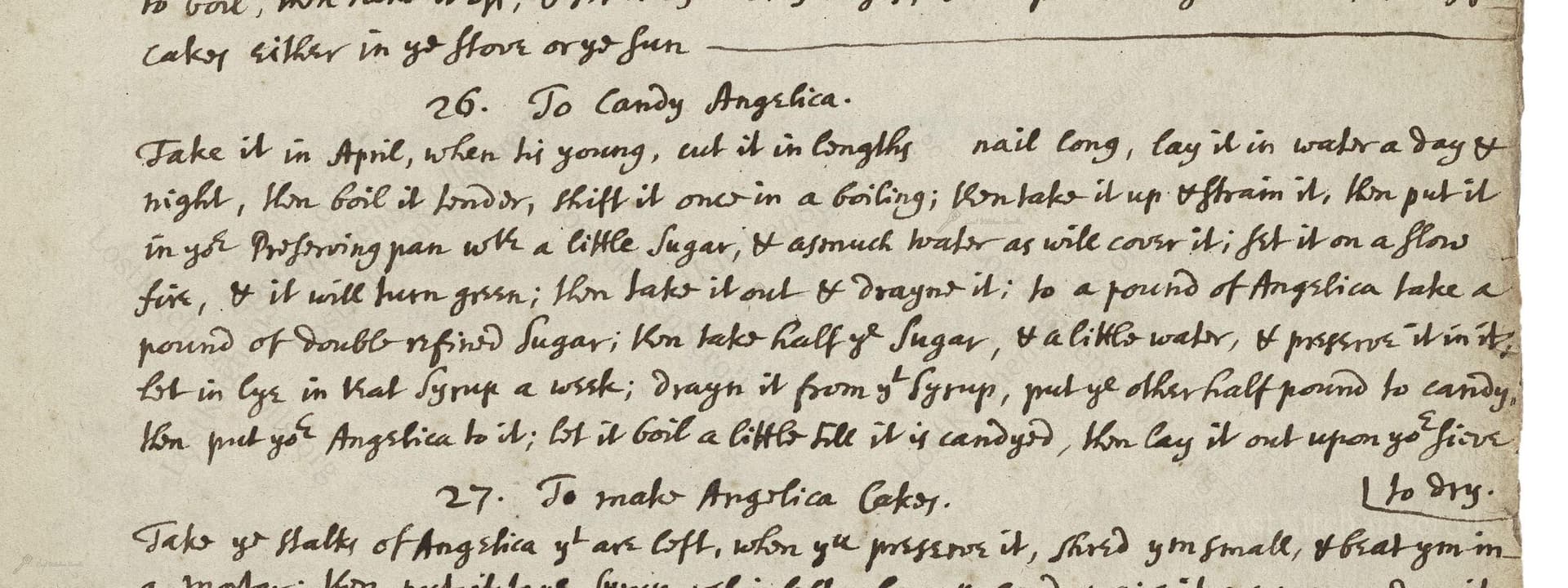To Candy Angelica
From the treasured pages of Cookbook of Mary Cruso and Timothy Cruso
Written by Mary Cruso

To Candy Angelica
"Take it in April, when it is young, cut it in lengths nail long, lay it in water a day & night, then boil it tender, shift it once in a boiling; then take it up & strain it, then put it in yor Preserving pan wth a little Sugar, & asmuch water as wile cover it; set it on a slow fire, & it will turn green; then take it out & drayn it; to a pound of Angelica take a pound of double refined Sugar; then take half ye Sugar, & a little water, & preserve it in it; let it lye in that syrup a week; drayn it from ye syrup, put ye other half pound to candy, then put yor Angelica to it; let it boil a little till it is candy'd, then lay it out upon ye sive to dry."
Note on the Original Text
Written in a conversational, practical tone, the recipe assumes substantial prior knowledge, omitting quantities (except for the sugar-angelica ratio) and specific times/temperatures. Unfamiliar spellings—such as 'ye' for 'the', 'yor' for 'your', and 'as much' written as 'asmuch'—reflect the orthography of late 17th-century England, when spelling was not standardized. Directions are brief, focused more on sequence than measurement, typical of manuscript cookery before printed cookbooks became widespread.

Title
Cookbook of Mary Cruso and Timothy Cruso (1689)
You can also click the book image above to peruse the original tome
Writer
Mary Cruso
Era
1689
Publisher
Unknown
Background
Step into the flavorful world of 17th-century cuisine with Mary Cruso’s delightful collection, where time-honored recipes and inventive cookery tips offer a peek at the tastes and talents of yesteryear’s domestic kitchens.
Kindly made available by
Folger Shakespeare Library
This angelica candying recipe dates to 1689 and is attributed to Mary Cruso, an Englishwoman living in a period when sugar cookery was both a medicinal art and a sign of refinement. Candying herbs like angelica was popular in England’s late 17th century, especially among the well-to-do who prized such sweets as digestive aids and decorative confections. April was chosen as young angelica is sweetest and most tender early in the growing season. Double-refined sugar refers to the whitest, purest sugar then available, an expensive luxury emphasizing both status and skill.

In Mary Cruso’s kitchen, this recipe would have called for a large preserving pan (usually copper or brass, tinned for safety), a boiling pot for blanching, wooden spoons, a strainer or sieve, and perhaps linen cloths for draining. Candying typically occurred over an open hearth or a slow charcoal fire, requiring great attention to keep the syrup from scorching. To dry the finished candy, a wire rack or finely woven sieve would be used.
Prep Time
30 mins
Cook Time
30 mins
Servings
10
We've done our best to adapt this historical recipe for modern kitchens, but some details may still need refinement. We warmly welcome feedback from fellow cooks and culinary historians — your insights support the entire community!
Ingredients
- 1 lb young angelica stalks (or substitute with green celery stalks for visual effect, noting flavor will differ)
- 1 lb double refined sugar (superfine white sugar)
- Water, as needed
Instructions
- Begin by sourcing young angelica stalks, ideally in April when they are tender and just emerging.
- Cut the stalks into pieces about the length of your fingernail (roughly 1.25-1.5 inches).
- Soak these pieces in cold water for 24 hours.
- Next, boil the angelica until just tender—change the water once during boiling to keep the flavor fresh.
- Drain and strain the pieces.
- Place them in a saucepan with enough water to cover and add a little sugar.
- Cook over low heat; the angelica will turn a vibrant green.
- Drain the angelica well.
- For every 1 pound (16 oz) of angelica, set aside 1 pound (16 oz) of double-refined (superfine) granulated sugar.
- Put half of this sugar (8 oz) in a pan with a little water to form a syrup and add the drained angelica.
- Let it sit in this syrup for about a week, refrigerated.
- After a week, drain the angelica.
- Prepare the remaining 8 ounces of sugar for candying—cook it to the soft crack stage with minimal water.
- Add the angelica and let it bubble gently until the syrup crystallizes on the surface.
- Spread the pieces on a wire rack or sieve to dry thoroughly.
Estimated Calories
120 per serving
Cooking Estimates
It takes about 30 minutes to cut, soak, and prep the angelica. Cooking will take about 30 minutes, and you'll need to let the angelica soak in syrup for a week for the best flavor. Each serving has around 120 calories, based mostly on the sugar used. This recipe yields about 10 servings.
As noted above, we have made our best effort to translate and adapt this historical recipe for modern kitchens, taking into account ingredients nowadays, cooking techniques, measurements, and so on. However, historical recipes often contain assumptions that require interpretation.
We'd love for anyone to help improve these adaptations. Community contributions are highly welcome. If you have suggestions, corrections, or cooking tips based on your experience with this recipe, please share them below.
Join the Discussion
Rate This Recipe
Dietary Preference
Main Ingredients
Occasions

Den Bockfisch In Einer Fleisch Suppen Zu Kochen
This recipe hails from a German manuscript cookbook compiled in 1696, a time whe...

Die Grieß Nudlen Zumachen
This recipe comes from a rather mysterious manuscript cookbook, penned anonymous...

Ein Boudain
This recipe comes from an anonymous German-language manuscript cookbook from 169...

Ein Gesaltzen Citroni
This recipe, dating from 1696, comes from an extensive anonymous German cookbook...
Browse our complete collection of time-honored recipes



